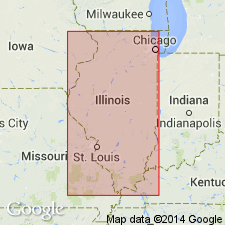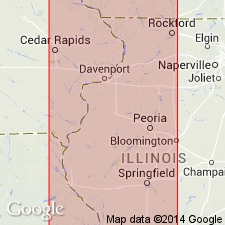
- Usage in publication:
-
- Grand Detour formation
- Modifications:
-
- Original reference
- Dominant lithology:
-
- Dolomite
- Limestone
- AAPG geologic province:
-
- Wisconsin arch
Summary:
Pg. 6, fig. 3. Grand Detour formation of Platteville group. Consists of dolomite or limestone, alternately pure and argillaceous, partly cherty, thin- to thick-bedded. Thickness about 500 feet. Subdivided into seven members (ascending): Dement, Walgreen, Stillman, Clement, Hely, Victory, and Forreston (all new). Underlies Nachusa formation (new); overlies Mifflin formation. Age is Middle Ordovician.
[Notable exposures in Dixon-Oregon area, northern IL.]
Source: US geologic names lexicon (USGS Bull. 1200, p. 1563).

- Usage in publication:
-
- Grand Detour Formation
- Modifications:
-
- Revised
- AAPG geologic province:
-
- Wisconsin arch
Summary:
Pg. 30. Grand Detour Formation. Revised in Illinois to include Cowen Member at base, below Stillman Member. Overlies Mifflin Formation. Age is Middle Ordovician. [See entry under Cowen.]
Source: Inferred from US geologic names lexicon (USGS Bull. 1564, p. 41).
For more information, please contact Nancy Stamm, Geologic Names Committee Secretary.
Asterisk (*) indicates published by U.S. Geological Survey authors.
"No current usage" (†) implies that a name has been abandoned or has fallen into disuse. Former usage and, if known, replacement name given in parentheses ( ).
Slash (/) indicates name conflicts with nomenclatural guidelines (CSN, 1933; ACSN, 1961, 1970; NACSN, 1983, 2005, 2021). May be explained within brackets ([ ]).

